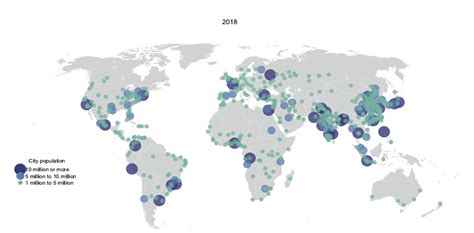Introduction
As the world’s population continues to grow, the number of megacities, defined as urban areas with populations exceeding 10 million, is rapidly expanding. These megacities are becoming increasingly significant in AP Human Geography, highlighting the need for a comprehensive understanding of their unique characteristics and challenges. This article delves into the multifaceted aspects of megacities, examining their demographics, spatial patterns, economic roles, and environmental implications.

Population Dynamics and Spatial Patterns
Megacities are home to a substantial portion of the world’s population. According to the United Nations, there were 33 megacities in 2018, with a combined population of over 570 million. By 2030, the number of megacities is projected to increase to 43, with a total population exceeding 740 million.
These megacities exhibit distinctive spatial patterns. They often develop around key transportation hubs, such as ports, airports, and major highways. As they expand, they incorporate surrounding smaller cities and towns, creating vast urban agglomerations. The most populous megacities include Tokyo, Delhi, Shanghai, Mexico City, and São Paulo.
Economic Significance
Megacities play a crucial role in the global economy. They serve as hubs for international trade, finance, and innovation. Many megacities are located in coastal areas, providing access to major shipping routes and facilitating global commerce. They also attract a large share of foreign direct investment and have become centers for multinational corporations.
Urbanization and Infrastructure
The rapid urbanization associated with megacities brings both opportunities and challenges. On the one hand, megacities offer access to employment, education, and cultural amenities. On the other hand, they face significant infrastructure challenges, including housing shortages, transportation congestion, and environmental pollution.
Megacities often struggle to provide adequate housing for their growing populations. This shortage can lead to the development of informal settlements, characterized by overcrowding, poor sanitation, and lack of basic services. Transportation systems in megacities are often overwhelmed by the sheer number of commuters, resulting in delays, congestion, and air pollution.
Environmental Challenges
Megacities are major contributors to environmental problems. Their dense populations and high levels of consumption generate vast amounts of waste and emissions. Air pollution, water pollution, and climate change are common challenges faced by megacities.
Table 1: Air Pollution in Megacities
| City | PM2.5 Concentration (μg/m³) |
|---|---|
| Beijing | 52 |
| Delhi | 48 |
| Mumbai | 44 |
| Mexico City | 33 |
| New York City | 12 |
Source: World Health Organization (2018)
Solutions and Innovations
Addressing the challenges of megacities requires innovative solutions. Urban planners are exploring ways to improve infrastructure, promote sustainable transportation, and reduce environmental impact.
Table 2: Innovative Transportation Solutions in Megacities
| City | Innovation |
|---|---|
| Singapore | Electronic road pricing |
| Curitiba, Brazil | Bus rapid transit system |
| London | Congestion charging |
| Bogotá, Colombia | TransMilenio bus system |
| Shenzhen, China | Smart traffic management |
Source: International Transport Forum (2019)
Planning for Megacities
The planning and management of megacities is essential for ensuring their sustainability and prosperity. Governments and urban planners are working to address the challenges of megacities through various strategies, including:
- Compact City Planning: Promoting dense, walkable, and mixed-use development to reduce sprawl and promote sustainability.
- Transit-Oriented Development: Encouraging residential and commercial development near public transportation hubs to reduce car dependency.
- Green Infrastructure: Incorporating parks, greenways, and other green spaces into urban design to improve air quality, reduce heat island effects, and enhance livability.
Conclusion
Megacities are complex and multifaceted phenomena that play a significant role in global affairs. They present both opportunities and challenges for governments, planners, and residents. By understanding the dynamics of megacities, we can develop innovative solutions to address their challenges and ensure their sustainability for future generations.
Additional Resources
- United Nations: https://population.un.org/wup/
- World Bank: https://www.worldbank.org/en/topic/urbandevelopment
- International Transport Forum: https://www.itf-oecd.org/
